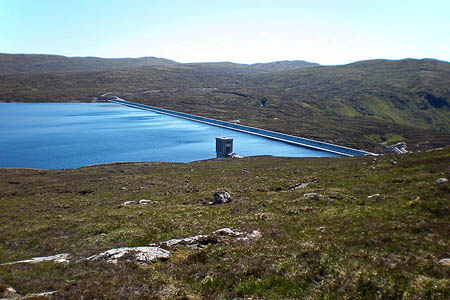
The windfarm would be built near the Glendoe Reservoir, built for a hydroelectric scheme. Photo: Sarah Maguire CC-BY-SA-2.0
A campaign group that includes outdoor luminaries has lodged a formal objection to a proposed windfarm.
The Save the Monadhliath Mountains group said the development in the Highlands would further deplete the diminishing wild land and would affect tourism.
SSE Renewables Developments wants to erect 83 turbines at Stronelairg, next to the Glendoe hydroelectric scheme 11km south-east of Fort Augustus.
But SMM campaigners are objecting to the plans because, they say, of the individual and cumulative landscape and visual impact on the sensitive landscape of the Monadhliath Mountains and the Cairngorms national park’s special qualities.
The group was originally formed to fight the Allt Duine windfarm in the Monadhliath Mountains on the boundary of the Cairngorms national park.
Outdoors journalist and writer Chris Townsend, a resident of the Cairngorms national park and spokesman for the group, said: “The Stronelairg windfarm would represent another blow to the sensitive landscape of the Monadhliath Mountains and the Cairngorms national park’s special qualities.
“The SMM campaign opposes the proposal on the basis that this scheme, alongside Allt Duine, would represent a step change in the cumulative effect of wind farms on the western and northern sides of the national park.”
The group’s objection also cites cumulative effects on tourism, as recent research has revealed that ‘unspoilt landscapes’ are by far the most popular reason for visitors to come to the Highlands it said.
“The height of each turbine is up to 135m and the equivalent to over two double decker buses; meaning they will be visible from the national park,” a spokesperson said.
SMM said they are also concerned about Scotland’s dwindling land resources, citing a recent study from Scottish Natural Heritage which found that the amount of Scotland visually unaffected by built development has decreased from 41 per cent in 2002 to 28 per cent in 2009 ‘primarily as a result of construction of windfarms and their associated infrastructure’.
SSE said: “The site itself is located within a large scale, high level plateau which is surrounded by a series of high summits and ridges, providing a degree of distant enclosure.
“This effectively restricts distant views into and out of this area from many directions, and particularly from the west. The plateau area includes a network of structures, some of them large and prominent, including tracks relating to the Glendoe hydroelectric scheme and management of the estate.
“Due to the relative remoteness and high altitude of the site, there will be a limited visual impact on settlements within the surrounding areas.
“Significant effort has been made to mitigate against any negative visual impacts. This is evident from the final design of the windfarm and the limited amount of low-lying areas from which it is visible.”
The Save the Monadhliath Mountains campaign is supported by writer and broadcaster Cameron McNeish; David Gibson, chief officer of the Mountaineering Council of Scotland, and the chief executive of the John Muir Trust Stuart Brooks, as well as 1,451 individuals and organisations.
alan.sloman
30 August 2012"two double decker buses"
I think someone's maths is a bit out here!
:-)
A double decker bus is about 4.5m tall so the proposed turbines are 30 double decker buses tall.
Andrew
30 August 2012I agree, that maths is quite badly flawed there.
This is of course another attempt by SSE and alike to get stuff through, destroy the environment, and grab the subsidies, before the world wakes up and plugs the subsidy gap.
Humphrey Weightman
30 August 2012The Monadliath - The Grey Mountains in Scots Gaelic - are the great invisible landscape resource. And why? Because they are - in the Central Highlands - inaccesable by road. We have but three main routes through the Highlands. And of these only two are used by tourists - the A9 from Edinburgh > Inverness, and the western approach via Glasgwow> Loch Lomond > Ft Augustus.
These two routes flank the Monadliath, but the massif per se is all but hidden. And here lies its special quality. To enter this range is to commit to a serious undertaking, whether on foot or on horseback. We have very few equivalent landscapes within the UK - the western Cairngorm and the area around Glken Tarff, the extreme NE beyond Ullapool and the Torridon region are comparable.
I fully understand that "The Wild" is but a construct - but I would urge you all to oppose with all your strength these short-term and misguided attempts to pillage our heritage for short-term monetary gain.
Humphrey Weightman
30 August 2012Sorry, but a locational error crept in just now. It's the pixies. I meant of course the NW beyond Ullapool. Not the NE.
Margaret
03 September 2012I posted this in another article; regarding a newspaper letter I read recently which had this catchy phrase "...subsidise an increasing forest of foreign-owned rotating cash machines".
The letter writer also observed that an engineer from India he was talking with said, "With the wind power industry it is common for governments to subsidise indigenous companies and help them to export goods and services. But here, you are subsidising foreign companies to bring goods in to the detriment of your own econemy and then handing them huge profits for the next 25 years which they take home."